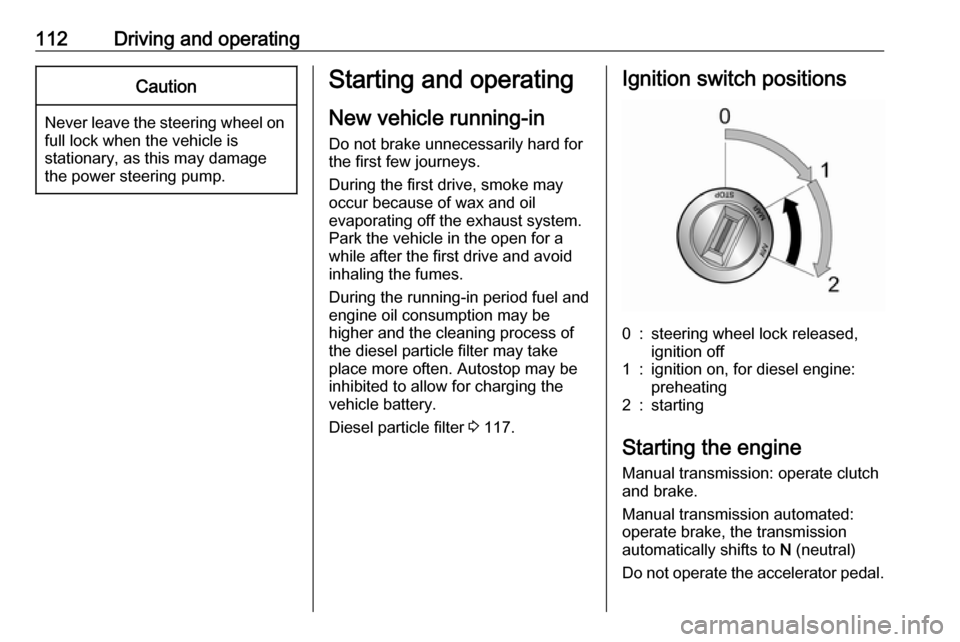fuel consumption OPEL COMBO 2017 Manual user
[x] Cancel search | Manufacturer: OPEL, Model Year: 2017, Model line: COMBO, Model: OPEL COMBO 2017Pages: 195, PDF Size: 4.71 MB
Page 95 of 195

Instruments and controls93See radio or Radio info (Display audio
and radio information)
Available depending on version,
activate radio info (set to On) to
display audio and radio information
(e.g. station frequency, RDS
messages, track number). Deactivate when not required (set to Off).
Autoclose (Automatic central locking
when driving)
Activate the autoclose feature (set to
On ) to automatically lock the doors
when vehicle speed exceeds
20 km/h. Deactivate when not
required (set to Off).
Units or Unit of Measurement (for Distance, Fuel consumption and
Temperature)
After accessing this menu option, it is
possible to set the unit of
measurement for distance, fuel
consumption and temperature.
Select Distance and confirm. Set the
unit of measurement to km or mi
(miles) and confirm.
Select Consumption and confirm.
When the Distance unit is set to km, it
is possible to set the unit ofmeasurement for fuel consumption to either l/100km or km/l . When the
Distance unit is set to mi (miles), fuel
consumption is shown in mpg.
Select Temperature and confirm. Set
the unit of measurement to °C or °F
and confirm.
Language
Languages selectable include:
English, German, French, Italian,
Portuguese, Spanish, Dutch, Polish and Turkish. Select desired language
and confirm.
Buzzer volume or Warning volume
(Warning chime volume)
Adjust the volume of warning chimes
and confirm. eight volume levels are
available.
Warning chimes 3 94.
Button vol. or Button volume
A chime is sounded every time
SET q, R or S is pressed.
Adjust the volume of these chimes
and confirm. eight volume levels are
available.
Warning chimes 3 94.Belt buzzer or Seat belt buzzer
(Reactivate warning chime for driver
and/or front passenger seat belt
reminder)
This menu option is available only if
the seat belt reminder is not active.
When reactivated, the driver and/or
front passenger are alerted with a
warning chime when the
corresponding seat belt is not
fastened.
Seat belt reminder 3 81.
Service (Distance to next service) Access this menu option to view the
remaining distance to the next service (available depending on version).
The distance to next service is also
displayed automatically when the
distance reaches 2,000 km and is
repeated after every additional
200 km.
Service display 3 77.
Page 98 of 195

96Instruments and controls● average consumption
● instantaneous consumption
● average speed
● travel time (driving time)
Multifunction version
Two trip odometers, Trip A and Trip
B, are available for selection and are
recorded separately.
The information of the two trip
computers can be reset separately,
making it possible to display different
trip distances.
Trip A ● range
● distance travelled
● average consumption
● instantaneous consumption
● average speed
● travel time (driving time)
Trip B ● distance travelled
● average consumption● average speed
● travel time (driving time)
Trip B can be deactivated via the
Driver Information Centre 3 89.
Reset trip computer information
To reset the trip computer, select one of its functions, then press and hold
TRIP for a few seconds.
The following trip computer
information will be reset:
● average consumption
● distance travelled
● average speed
● travel time (driving time)
A confirmation message appears in the display when the trip computer is
reset.
Note
The trip computer will reset
automatically when the maximum
value of any of the parameters is
exceeded.
Outside temperature
The temperature outside the vehicle
is displayed (depending on version).Outside temperature 3 71, 3 89.
Range The range is calculated from the
current contents of the fuel tank and
the average consumption since the
last reset.
When the range is less than 50 km,
_ _ _ _ will appear in the display.
After refuelling, the range is updated
automatically after a brief delay.
The measurement can be restarted at
any time.
Note
The range will not be displayed if the
vehicle is left parked with the engine
running for a long time.
Distance travelled
Displays the distance driven since the last reset.
The measurement can be restarted at
any time.
Page 99 of 195

Instruments and controls97Average consumptionAverage consumption is displayed,taking into consideration the distance
travelled and the fuel used since the
last reset.
The measurement can be restarted at
any time.
Instantaneous consumption
Display of the instantaneous fuel
consumption.
_ _ _ _ will appear in the display if the
vehicle is left parked with the engine
running for a long time.
Average speed
The average speed since the last
reset is displayed.
The measurement can be restarted at
any time.
Interruptions in the journey with the
ignition off are not included in the
calculations.
Travel time (driving time)
The time elapsed since the since the
last reset is displayed.The measurement can be restarted at
any time.
Exit trip computer To exit the trip computer, press and
hold SETq for more than
two seconds.
Driver Information Centre 3 89.
Interruption of power supply
If the power supply has been
interrupted or if the vehicle battery
voltage has dropped too low, the
values stored in the trip computer will
be lost.
Page 113 of 195

Driving and operating111Driving and
operatingDriving hints ............................... 111
Control of the vehicle ...............111
Steering ................................... 111
Starting and operating ...............112
New vehicle running-in ............112
Ignition switch positions ...........112
Starting the engine ..................112
Vehicle shutdown ....................113
Overrun cut-off ........................ 114
Stop-start system ....................114
Parking .................................... 116
Engine exhaust .......................... 117
Diesel particle filter ..................117
Catalytic converter ...................118
Manual transmission ..................118
Manual transmission automa‐ ted .............................................. 119
Transmission display ...............119
Starting the engine ..................119
Selector lever .......................... 120
Manual mode ........................... 121
Electronic driving programmes 122
Fault ........................................ 122Brakes........................................ 123
Antilock brake system .............123
Parking brake .......................... 124
Brake assist ............................. 124
Hill start assist ......................... 125
Ride control systems .................125
Traction Control system ..........125
Electronic Stability Control ......126
Driver assistance systems .........127
Cruise control .......................... 127
Parking assist .......................... 129
Fuel ............................................ 131
Fuel for petrol engines .............131
Fuel for diesel engines ............131
Fuel for natural gas operation . 131
Refuelling ................................ 132
Fuel consumption - CO 2-
Emissions ............................... 134
Trailer hitch ................................ 135
General information .................135
Driving characteristics and towing tips .............................. 135
Trailer towing ........................... 135Driving hints
Control of the vehicle
Never coast with engine not
running (except during Autostop)
Many systems will not function in this
situation (e.g. brake servo unit, power
steering). Driving in this manner is a
danger to yourself and others. All
systems function during an Autostop,
but there will be a controlled reduction in power steering assist and vehicle
speed is reduced.
Stop-start system 3 114.
Pedals
To ensure the pedal travel is
uninhibited, there must be no mats in the area of the pedals.
Steering If power steering assist is lost
because the engine stops or due to a system malfunction, the vehicle can
be steered but may require increased
effort.
Page 114 of 195

112Driving and operatingCaution
Never leave the steering wheel on
full lock when the vehicle is
stationary, as this may damage
the power steering pump.
Starting and operating
New vehicle running-in Do not brake unnecessarily hard for
the first few journeys.
During the first drive, smoke may
occur because of wax and oil
evaporating off the exhaust system.
Park the vehicle in the open for a
while after the first drive and avoid
inhaling the fumes.
During the running-in period fuel and
engine oil consumption may be
higher and the cleaning process of the diesel particle filter may take
place more often. Autostop may be
inhibited to allow for charging the
vehicle battery.
Diesel particle filter 3 117.Ignition switch positions0:steering wheel lock released,
ignition off1:ignition on, for diesel engine:
preheating2:starting
Starting the engine
Manual transmission: operate clutch
and brake.
Manual transmission automated: operate brake, the transmission
automatically shifts to N (neutral)
Do not operate the accelerator pedal.
Page 119 of 195

Driving and operating117● Close the windows.
● Turn the ignition key to position
0 and remove it from the
ignition switch. Turn the
steering wheel until the
steering wheel lock is felt to
engage.
● Lock the vehicle 3 24.
● Activate the anti-theft locking system 3 29.
Note
In the event of an accident with
airbag deployment, the engine is
turned off automatically if the vehicle comes to a standstill within a certain
time.
Engine exhaust9 Danger
Engine exhaust gases contain
poisonous carbon monoxide,
which is colourless and odourless and could be fatal if inhaled.
If exhaust gases enter the interior
of the vehicle, open the windows.
Have the cause of the fault
rectified by a workshop.
Avoid driving with an open load
compartment, otherwise exhaust
gases could enter the vehicle.
Diesel particle filter
The diesel particle filter system filters
harmful soot particles out of the
exhaust gases. The system includes
a self-cleaning function that runs
automatically during driving without
any notification. The filter is cleaned
by periodically burning off the soot
particles at high temperature. This
process takes place automatically
under set driving conditions and may
take up to 25 minutes. Typically it
needs 15 minutes. Autostop is not
available and fuel consumption may
be higher during this period. The
emission of smells and smoke during
this process is normal.
Under certain driving conditions, e.g.
short distances, the system cannot
clean itself automatically.
If the cleaning of the filter is required
and if previous driving conditions did
not enable automatic cleaning, it will
be indicated by control indicator %.
Depending on version, a warning
message may also appear in the
Driver Information Centre 3 89.
Page 124 of 195

122Driving and operatingspeed is too high, the transmission
only switches to a higher gear via
kickdown 3 122.
When gearshifting is recommended
to improve fuel economy, control indicator [ or Ò illuminates in the
Driver Information Centre 3 84.
Electronic driving programmes
Eco mode E
When automatic mode is engaged,
the Eco mode can be selected to
reduce fuel consumption.
Eco mode selects the most suitable gear depending on the speed of the
vehicle, the engine speed and the
intensity with which the accelerator is pressed.
Activation
Press E on the selector lever housing.
Control indicator E is shown in the
transmission display to indicate
activation.
Deactivation
Eco mode is switched off by:
● pressing E again
● switching to manual mode
In order to protect the transmission at extremely high clutch temperatures,
an intermittent audible warning chime
may sound. In such cases, depress
the brake pedal, select N and apply
the parking brake to allow the clutch
to cool down.
Kickdown If the accelerator pedal is pressed
past the pressure point, the
transmission shifts to a lower geardepending on engine speed. Full
engine power is available for
acceleration.
If engine speed is too high the
transmission switches to a higher
gear, even in manual mode. Without
kickdown this automatic shift is not
effected in manual mode.
Fault
In the event of a fault, control indicator s is shown in the transmission
display.
Continued driving is possible,
provided the vehicle is driven with
care and anticipation. A warning
Page 136 of 195

134Driving and operatingTerms for "natural gas " abroad:GermanErdgasEnglishCNG = Compressed
Natural GasFrenchGNV = Gaz Naturel (pour)
Véhicules - or -
CGN = carburantgaz
naturelItalianMetano (per auto)
Fuel filler cap
Only use genuine fuel filler caps.
Diesel-engined vehicles have special fuel filler caps.
Fuel cut-off system
In the event of a collision of a certain
severity, the fuel system is cut-off and
the engine is switched off
automatically, for safety reasons.
Resetting the fuel cut-off system;
refer to "Fuel system messages"
3 95.
Fuel consumption - CO
2-
Emissions
The fuel consumption (combined) of
the model Opel Combo is within a
range of 7.7 to 4.5 l/100 km.
Depending on country, the fuel
consumption is displayed in km/l. In
this case, the fuel consumption
(combined) of the model Opel Combo is within a range of 13.0 to 22.2 km/l.
The CO 2 emission (combined) is
within a range of 179 to 120 g/km.
For the values specific to your
vehicle, refer to the EEC Certificate of
Conformity provided with your vehicle or other national registration
documents.
General information
The official fuel consumption and
specific CO 2 emission figures quoted
relate to the EU base model with
standard equipment.
Fuel consumption data and CO 2
emission data are determined
according to regulation R (EC)
No. 715/2007 (in the latest applicableversion), taking into consideration the
vehicle weight in running order, as specified by the regulation.
The figures are provided only for the
purpose of comparison between different vehicle variants and mustnot be taken as a guarantee for the
actual fuel consumption of a
particular vehicle.
Additional equipment may result in
slightly higher results than the stated
fuel consumption and CO 2 figures.
Furthermore, fuel consumption is dependent on personal driving style as well as road and traffic conditions.
Natural gas
The fuel consumption information
was obtained using reference fuel
G20 (methane proportion
99 - 100 mol%) under prescribed
driving conditions. When using
natural gas with a lower proportion of
methane, the fuel consumption can
differ from the specified values.
Page 139 of 195

Vehicle care137Vehicle careGeneral Information...................137
Accessories and vehicle modifications .......................... 137
Vehicle storage ........................138
End-of-life vehicle recovery .....138
Vehicle checks ........................... 139
Performing work ......................139
Bonnet ..................................... 139
Engine oil ................................. 140
Engine coolant ......................... 141
Power steering fluid .................141
Washer fluid ............................ 142
Brakes ..................................... 142
Brake fluid ............................... 142
Vehicle battery ......................... 143
Wiper blade replacement ........144
Bulb replacement .......................145
Halogen headlights ..................145
Fog lights ................................. 147
Tail lights ................................. 147
Side turn signal lights ..............148
Centre high-mounted brake light ......................................... 148
Number plate light ...................148Interior lights ............................ 149
Instrument panel illumination ...150
Electrical system ........................151
Fuses ....................................... 151
Engine compartment fuse box . 152
Instrument panel fuse box .......153
Vehicle tools .............................. 154
Tools ........................................ 154
Wheels and tyres .......................155
Winter tyres ............................. 155
Tyre designations ....................155
Tyre pressure .......................... 156
Tyre pressure monitoring
system .................................... 157
Tread depth ............................. 158
Changing tyre and wheel size . 159 Wheel covers ........................... 159
Tyre chains .............................. 159
Tyre repair kit .......................... 159
Wheel changing .......................162
Spare wheel ............................ 163
Jump starting ............................. 166
Towing ....................................... 167
Towing the vehicle ...................167
Towing another vehicle ...........168
Appearance care .......................169
Exterior care ............................ 169
Interior care ............................. 171General Information
Accessories and vehiclemodifications
We recommend the use of genuine
parts and accessories and factory
approved parts specific for your
vehicle type. We cannot assess or guarantee reliability of other products
- even if they have a regulatory or
otherwise granted approval.
Any modification, conversion or other
change made to standard vehicle
specifications (including, without
limitation, software modifications,
modifications of the electronic control units) may invalidate the warrantyoffered by Opel. Furthermore, such
changes may impact fuel
consumption, CO 2 emissions and
other emissions of the vehicle and
cause the vehicle to no longer
conform to the type approval,
impacting the validity of your vehicle
registration.
Page 191 of 195

189Cigarette lighter ........................... 74
Climate control ............................. 16
Climate control systems .............105
Clock....................................... 71, 89
CNG............................................ 184
Collision damage repair ..............186
Control indicators.......................... 78
Control of the vehicle .................111
Controls ........................................ 69
Convex shape .............................. 30
Coolant and antifreeze ...............173
Cruise control ...................... 89, 127
Cupholders .................................. 60
D Danger, Warnings and Cautions ...4
Date .............................................. 89
Daytime running lights ............89, 99
Declaration of conformity ............186
Diesel particle filter ...............85, 117
Distance to next service ...............89
Door open .................................... 89
Doors ...................................... 26, 27
Drain fuel filter ............................. 88
Driver assistance systems ..........127
Driver Information Centre .............89
Driving characteristics and towing tips .............................. 135
Driving hints ................................ 111E
Eco mode (E).............................. 122
Electric adjustment ......................30
Electrical system......................... 151
Electronic climate control system 107
Electronic driving programmes ..122
Electronic Stability Control ..84, 126
Electronic Stability Control (ESC). 84
End-of-life vehicle recovery .......138
Engine compartment fuse box ...152
Engine coolant ........................... 141
Engine coolant temperature ........85
Engine coolant temperature gauge ....................................... 77
Engine data ............................... 178
Engine exhaust .......................... 117
Engine identification ...................176
Engine oil ...........140, 173, 177, 184
Engine oil pressure ......................86
ESC (Electronic Stability Control) 126
Event data recorders ..................186
Exit lighting ................................ 104
Extendable load compartment cover ................................... 62, 66
Exterior care .............................. 169
Exterior light ................................. 88
Exterior lighting ......................13, 98
Exterior mirrors ............................. 30F
Fault ........................................... 122
Fixed air vents ........................... 109
Fog light ....................................... 89
Fog lights ................................... 147
Folding front passenger seat ........38
Folding mirrors ............................. 30
Folding seats .......................... 40, 42
Front airbag system .....................51
Front fog lights ........................... 100
Front passenger seat Folding ...................................... 38
Table position ............................ 38
Front seats.................................... 36
Front storage ................................ 60
Front turn signal light ..................145
Fuel............................................. 131
Fuel consumption .........................89
Fuel consumption - CO 2-
Emissions ............................... 134
Fuel cut-off system .........80, 95, 113
Fuel for diesel engines ..............131
Fuel for natural gas operation ...131
Fuel for petrol engines ...............131
Fuel gauge ................................... 76
Fuel selector ................................ 76
Fuel system messages .........95, 113
Fuel tank ..................................... 184
Fuses ......................................... 151